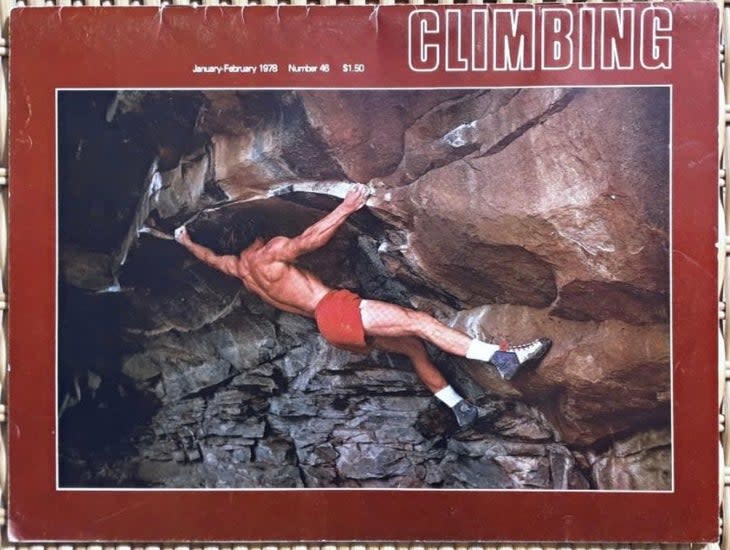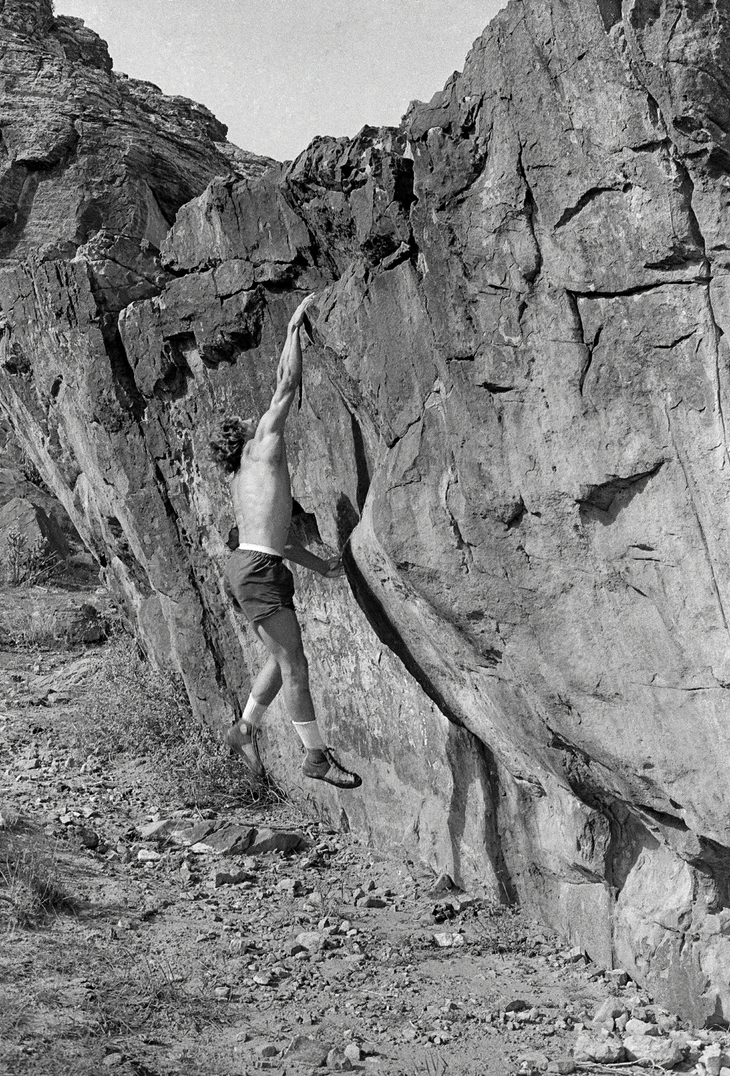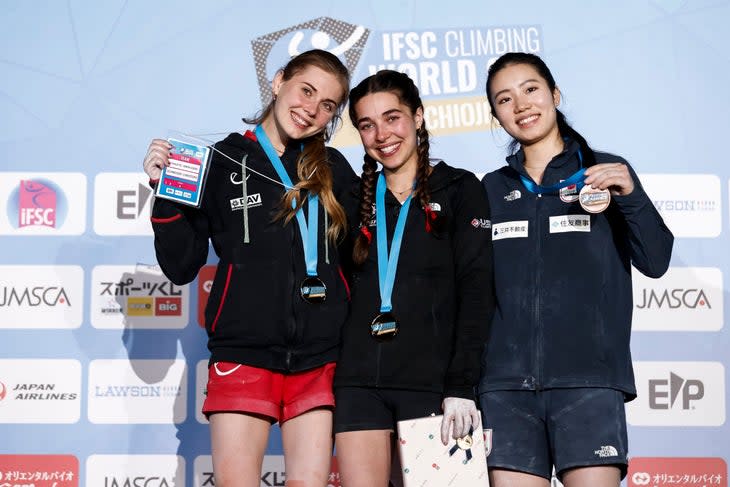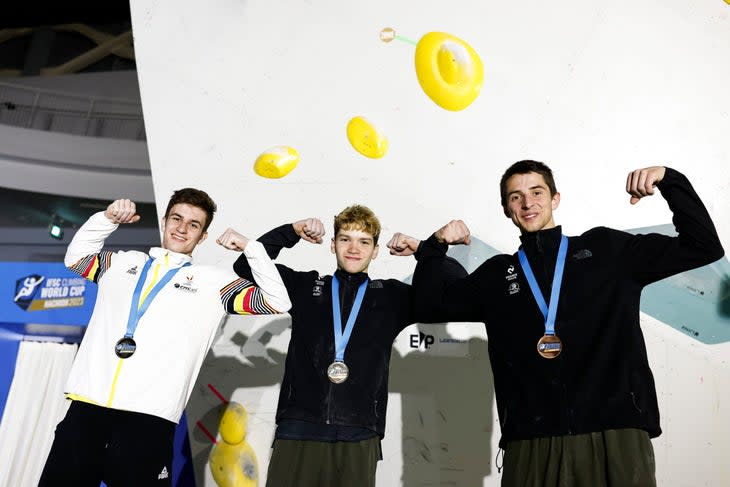True Fact: John Long, Stonemaster, is a Bouldering World Cup Junkie
This article originally appeared on Climbing
1970. During a Rock 1 course out at Mount Rubidoux, near Riverside, California. I'd just learned the figure 8 follow through when Phil Haney--in skin-tight, smooth-soled climbing shoes, his hands dusted with chalk--campused up the overhanging, 30-foot high, Joe Brown Wall. My eyes went out on stilts. I walked over and clasped the first holds, which felt like hacksaw blades, and burst out laughing.
"That there's bouldering," my instructor said, but it looked like magic to me. And Phil Haney was a regular Merlin.
Six summers later, with a copy of Pat Ament's Master of Rock in hand (basically a photo-essay on John Gill, "Father of American bouldering"), Climbing Magazine editor Michael Kennedy and I piled into his wheezy Fiat and tooled around central Colorado, hitting Flagstaff, Split Rock, Horsetooth Reservoir, down to Pueblo, and beyond, where starting in the late 1950s, Gill debuted dynamic climbing techniques on a slew of iconic boulder problems.

I frequently bouldered, mostly as practice for trying to free climb Yosemite big walls--my obsession back then. Michael, meanwhile, was questing up frozen mountains in Alaska and later that year came within a stone's throw of bagging the FA of the North Ridge of Latok I, one of mountaineering's greatest prizes. We'd both heard the legends about Gill levitating up holdless rock, stories rarely mentioned in the blinkered climbing media. That is, until Ament wrote Master of Rock, and Michael had a wise idea.
I'd crank as many Gill creations as possible, far and wide, with Michael snapping photos. Then I'd write an article and Michael would run it in Climbing as a cover story. The notion of a "bouldering expedition," chasing the ghost of John Gill, felt as silly and exciting as searching for Paul Bunyan. We had no idea how readers might feel about it.


The highlight of our adventure was meeting John Gill himself, down in Pueblo, getting a guided tour of his private reserve, and repeating a few classic Gill problems--which favored the jumping-bean style I most admired. To my surprise, our article ("Pumping Sandstone") blew up, and helped kick-start the modern bouldering rage, though how bouldering would evolve--as both an athletic pursuit and an Olympic sport--was something Michael and I could never have imagined. John Gill, I suspect, had seen it all coming, decades before.
2023. Forty-five years after "Pumping Sandstone" was hot off the press, and 5,477 miles from my place in Venice Beach, California, at the Esforta Stadium on the outskirts of Tokyo, 171 climbers from dozens of countries have gathered for a Bouldering World Cup, which kicks off the 2023 IFSC season.
I've dragged myself out of bed at an ungodly early hour to watch the live stream, gagging down a quad shot and two Krispy Kreme Custard Filled to get my engine running. I could wait a few hours and leisurely screen the comp on YouTube. But shit, man, if hard bouldering's going down, I can never wait, even if I can't do it anymore.
That sound on my laptop, over on my desk, is British announcer Matt Groom describing the format for the finals: Four boulder problems, six climbers, three podium places, in a men's final so beastly hard that two-time World Bouldering Champion Tomoa Narasaki bombed out in the semis.
Groom says to keep an eye on 18-year old wunderkind, Hannes Van Duysen, the first Belgium climber to have a shot at a World Cup medal. And magnetic French whippersnapper, Mejdi Schlack, also 18, who moves with a shapeshifter's mojo while flashing his dopy, endearing smile, reminiscent of Bocephus, the ventriloquists' dummy from Gran 'Ol Opry.
Rounding out the field are Kokoro Fujii, six-time World Cup winner, and the old man at 30; his countryman, Sarato Anraku, just 16, yet another Japanese gym climbing prodigy; celebrated South Korean boulderer, Jongwon Chon, 27, with the razor cut do and arty tats; and dazzling French grimpeur, Paul Jenft, 19, who slayed the junior tour, and has qualified first here in Japan.
Kokoro, who qualified last, gets the comp rolling, jumping straight off the mat to an unbearable bear hug off a swollen pink volume, feet dangling, his arms so outspread he resembles Da Vinci's Vitruvian man viewed from behind. Then a windmill crossover with the right hand, stabbing for a donut hold, the hole sloping as the shingles on the Sydney Opera House--and only wide enough for one paw. Kokoro sticks the first donut, but quickly glazes off on further attempts. Same for the consummate Belgium, Van Duysen, who follows.
Then Mejdi Schlak, in the French team's saucy black tank top and short shorts ensemble, bursts from iso, sprints across the mat and hurls himself at the problem, sticking the first donut on his fourth try, only to huck a deleterious dyno to pair of dual-tex bread loaf holds bolted nearly vertically onto the wall, which Mejdi sticks via a disturbing Gaston. Then another big dyno to a second donut and Schlack logs the first and only send of boulder one. A perfunctory chest bump and growl, then the Frenchman, to wild applause, dashes off the stage and through the curtain back to iso. One problem down. Three to go.
Back in the early-1970s, a few years before "Pumping Sandstone," most of us moved slow and static as a ladybug wheedling up a Lodgepole pine. As the angle steepened and the holds rounded off, thrusting off foot holds, while slapping up top, carried us over grim stone with style and dispatch. Took a while to master open-handed climbing, to dial in dead-point timing, and to latch holds with muscles engaged; but practice on the boulders made perfect, and leading climbers started flying for it.
Old school duffers dissed dynamic movement as cheating, since a sober leader, a dozen feet out on a wired RP, would never start hucking dynos. This was the Indian Summer of the trad era, when bolts were shunned and arranging protection remained a critical concern. But dedicated boulderers were appearing at every small crag across the country, and how their artistry translated to roped climbing was an increasingly irrelevant question.

(Photo: John Long Collection)
But what about the fabled John Gill? Faster than a speeding bullet. More powerful than a locomotive. Able to leap tall boulders in a single bound--or so we'd heard. How might we match up with the master, in terms of dynamic movement, which was starting to dominate our curriculum? Michael Kennedy cooked up "Pumping Sandstone" to answer that question, one way or another. I was mostly the stunt dummy.
Boulder Problem 2 attacks a cruel slab, a degree or two off vertical. The only holds are widely-spaced orbs resembling piebald beach balls sawed in half. Plus a jib the size of a chickpea. Kokoro Fujii, Sarato Anraku, and Jongwon Chon all gain the beach balls by jumping onto small dual tex volumes offering puny, textured "slab" patches, secretly oiled or buttered judging by the continuously skating shoe rubber. Then several no-hand leg presses off the unctuous beach balls, all finesse and body English on this "slow slab," requiring glacial-speed moves and absolute trust in your feet. But no tops, till Hans Van Dysen shows us what champion slab climbing looks like when he ticks the slab second try.
Then Medji Schlack dashes from behind the iso curtain because he's dashing like that and, face plastered to the wall, teeters, presses, and balances to the top the slab on his third try. Medji wails and pumps his fist, as before, but rather than race off, he saunters toward the curtain, his arms outstretched, palms up, like Napoleon after the Battle of Austerlitz. Medji's worth the price of admission. The straw that stirs the World Cup drink. The crowd goes off.
Then comes Paul Gent, Medji's ami prochet and longtime training partner on Team France.
"I'm happy to finally be in zee finals," said Jenft, earlier in the day, "but I'm also frustrated because Mejdi always beats me. We'll zee how it goes."
Monsieur Gent, to the amazement of the beetling crowd, hikes the slab on his second try. Take that, Mejdi. No one else tops the slab. After two of four rounds, only Mejdi has managed two tops.
La Jolla Beach, nearby San Diego. Ricky Accomazzo and I are scraping over the 20-foot, salt-washed boulders girding Black's Beach, renown for body surfing and nude bathing. Withal a swank bouldering venue for two kids still in high school. And Ricky and I were onto a masterwork, sporting an incut rail for our hands and a second, lower rail to kick off, all the better to sail sky high. And we'd need to since the next hold, a big hueco with a sandy lip, loomed a body-length higher. We both could huck the big pull-and-jump to the hueco, but with too much body swing to stick the latch, which sent us windmilling into the sand, face first and from way up there.
Then Ricky suggested we fire for the hueco with both hands, instead of one. Carving the air with hands and feet detached, to us schooled to "always maintain three points of contact," felt frightening and illegal. So we tried it straightaway, and both quicky got it. Why not? Gymnasts had for decades thrown full dislocate moves on the high bars. But the first time we pulled a double mo on the rock, it felt like discovering fire.
The previous generation of Yosemite pioneers cast such long shadows, it felt almost impossible to bust into the light with something all our own. The double mo was where we stepped into the future--or thought we had. Imagine my surprise when I first toured Colorado with John Bachar, and later with Michael Kennedy for "Pumping Sandstone," and encountered the Pinch Overhang, Left Eliminator (classic dynos at Horsetooth Reservoir), and the much harder fare down in Pueblo, where (c. 1965) a young math professor named John Gill started chucking double-clutch dynos when I was still pissing my pants in nursery school. Who knew?
Kokoro Fujii squirts liquid chalk onto his mitts, heaves off twin acorns and slaps for a sloper, clasps a middling lieback rill, winds up and launches into a run and jump, via rapid fire paddle dynos off dual-tex sidepulls, with sloped volumes for his feet. Once airborne, Kokoro-San must keep it going by swiping successive holds--rather like swinging across an off-axis jungle gym--and hucking at last for a final sidepull bolted twenty feet right of the launch point. Kokoro-San never gets close on the problem that is a microcosm of current World Cup bouldering, which just a few seasons back, resembled movements found at your local crag. But not so much any more.
Gym bouldering needed to create its own, spectator-friendly rodeo, including these fashionable run and jumps--all part of the charge toward dynamic aerobatics. Such problems borrow heavily from the wall runs and bar swings found in parkour, requiring great explosive power, and fantastic coordination and timing to pull off. Because training props and routines are so advanced, and World Cup climbers are so skilled and adaptive, route setters are forever concocting novel movements to defy the competitors and keep the journey fresh. The unspoken aim is to add some wrinkle to the standard repertoire of moves, keeping the whole megillah a contest of discovery, and a total blast to watch. But it ain't easy dreaming up and setting those problems, to say nothing of climbing them. Believe it. It takes many years, and all their heart and soul, for setters and climbers to achieve a World Cup final. These pros earn their money.
Only Medji gets close to topping Problem 3, but violent body swing rips his hands off the final sidepull, and he helicopters into the mat and has to lump it.
Three years after "Pumping Sandstone," Canadian big wall pioneers Steve Sutton, Hugh Burton and I were exploring the dirt roads near Idyllwild, California--the small mountain hamlet below Tahquitz and Suicide Rock--when we rolled into Black Mountain campground and found ourselves surrounded by stunning granite boulders ten to forty feet high. Simply topping the hundreds of formations--which we started attempting right off--was the obvious first task, and I felt like Edward Whymper, c. 1890, peak bagging in the alps, though on a smaller scale, of course. A rope was never used because John Gill, we figured, would never have bothered with a cord. Not when he could highball. And Professor Gill could highball.
Following many exciting adventures at Black Mountain, c. 1980, I wrote "Pumping Granite," which poured a little gas on the bouldering bonfire, and paid homage to two seminal Gill highballs I first encountered while pumping sandstone: the harrowing Thimble, which Ament described as "a 30-foot-tall, mitten-shaped pinnacle rising out of the Needle’s Eye pullout on the Needles Highway" (Custer State Park, South Dakota), and which, way back in 1961, Gill redpointed in lug soled boots, at 5.12a/b (when the hardest roped climbs were 5.10). And the punishing Gill Crack, at Castle Rock, in Boulder Canyon, a 30-foot, 5.12 finger crack that Gill soloed in the mid-1960s and which almost cost me two shattered legs (fat fingers are a liability up top).
Several years later, pawing up classic Black Mountain highballs like Moroccan Roll, Hank Panky, and Where Boneheads Dare, dynos, deadpoints, and highballs were standard practice, and presaged the current trends in both outdoor bouldering and indoor comps, where thankfully, cushiony mats soften the towering, out-of-control whippers often logged on the trampoline dynos for which World Cup Bouldering is renown.


The fourth and final problem features bulbous volumes set on opposite sides of a shallow, wickedly overhanging corner. Opposing, cross-pressured palms and dire stems might, it appears, install a mountaineer on the wall, rather like a clothes rack in a closet. But which way to face? In, or out?
Kokoro can't crank it. Van Duysen can fly some, but not high enough. Schlack attacks but jacks his back attempting the clothes rack. The fourth problem goes unclimbed.
All told, six world-class boulderers have thrown down dozens of all-out attempts on four boulder problems, resulting in a paltry four tops. Mejdi is the only competitor to manage two. These problems are hard.
The women's final had run the previous day but only appears on YouTube an hour after the men's finals. Just time enough to pound another quad shot and two more Krispy Kreams as I watch American Brooke Raboutou, 22, with spectacular focus and authority, end up one hold shy of ticking all four problems. Austrian Hannah Muel takes home the silver, though the fraulein only manages one top. None of the four other four finalists top a single problem.
If a smile could translate into green money, Brook's is worth a billion dollars. Her many friends--including announcer Matt Groom--shed tears for the Boulderite and her first World Cup gold.
The following weekend, in Seoul, South Korea, Brooke takes the bronze (all three medalists only manage 2 tops apiece), and Medji snags the gold once more. World Cup finals are nigh impossible to achieve, and any finalist can win on a given day. But going forward, Brooke Raboutou and Mejdi Schlack might well become fixtures on the podium.


Yet every insider wonders: what happens when Slovenian World and Olympic Champion Janja Garnbret returns from a toe injury, which should happen June 2, at the Prague Bouldering World Cup. Every sport needs a superstar, and comp climbing has Janja. Few champions dominate with Janja's skill, fearlessness, and grace. Sixty odd years ago, when John Gill pictured a future bouldering hero, I imagine she looked exactly like Janja Garnbret. That a gang of up-and-comers are gunning for the Slovenian star is what makes World Cup climbing so enticing. But the soul of bouldering runs deeper than personalities or superhero moves on plastic or rock.
Back in the 1950s, legendary jazz trumpeter Miles Davis would start a recording session with nothing written down. No charts for the songs. Just a key and a few cord changes. He never told his fellow musicians what to play, only that they had to be working on something new. Some voicing. Some technique they wanted to make their own. Years later, Miles' fellow musicians all had stories about those legendary sessions, when through spontaneous works of genius, they discovered the new and unexpected, and left us the best American music ever made.
Bouldering, like music that lasts, is not, finally, its medium nor its style; rather, something before, behind, above, and beyond all notes and all movement. None of us outlives our own time. What does is the magic of discovery, and what a climber becomes when it's the air you breathe and the ground you cover. A sparkle silently passed on from John Gill to climbers of my generation, and which boulderers ever since have made their own, and dynoed to the stars.
Also By John Long:
EDITORS' PICKS
For exclusive access to all of our fitness, gear, adventure, and travel stories, plus discounts on trips, events, and gear, sign up for Outside+ today.

